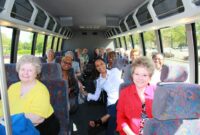Travel companions for seniors are increasingly important, offering crucial support and enhancing the enjoyment of travel. This guide explores various companion types, from guided tours and personal assistants to family members, weighing the pros and cons of each. We’ll delve into crucial factors for selection, including health considerations, budget constraints, and desired activities, ensuring a safe and enriching travel experience for seniors.
Choosing the right companion significantly impacts the success and enjoyment of a senior’s journey. This guide provides a structured approach to finding, vetting, and planning trips, emphasizing safety, well-being, and budgetary considerations throughout the process. We will also address common concerns and offer practical tips to make the entire experience seamless and memorable.
Factors to Consider When Choosing a Travel Companion
Selecting the right travel companion is crucial for a successful and enjoyable senior travel experience. The ideal companion will enhance the trip, not detract from it. Careful consideration of several key factors will significantly improve the chances of a positive outcome.
Choosing a travel companion involves more than simply picking a friend or family member. Compatibility, shared interests, and practical considerations like health and budget all play vital roles in ensuring a smooth and memorable journey. A mismatch in any of these areas can lead to friction and ultimately, a less enjoyable experience.
Health Conditions and Physical Limitations
It’s essential to assess both your own and your potential companion’s health status. Pre-existing conditions, mobility limitations, and any necessary medical assistance should be openly discussed and accounted for. For example, if one individual requires frequent rest stops or has limited mobility, choosing destinations and activities that accommodate these needs is paramount. Travel insurance that covers pre-existing conditions is also highly recommended. Consider the accessibility of chosen accommodations and transportation options. A companion who can provide assistance, if needed, could be invaluable.
Budgetary Considerations
Financial compatibility is a critical aspect. Openly discussing travel budgets and expenses, including flights, accommodation, activities, and meals, is vital to avoid misunderstandings and financial strain on either party. A clear understanding of who is responsible for which expenses will prevent potential conflicts. For example, one person might be responsible for flights while the other covers accommodation. Alternatively, expenses could be split equally. Transparent financial planning ensures a stress-free trip.
Shared Interests and Travel Styles
Shared interests and travel styles significantly impact the enjoyment of a trip. If one person prefers fast-paced sightseeing and the other prefers a relaxed pace with ample downtime, conflict is likely. Similarly, differences in preferences for accommodation (luxury vs. budget), food (fine dining vs. casual), and activities (adventure vs. relaxation) can lead to friction. A shared love for history, culture, or nature can foster a more harmonious travel experience. For instance, two individuals who both enjoy hiking would find a trekking holiday more enjoyable than a couple with differing preferences.
Personal Comfort and Compatibility
Beyond shared interests, personal compatibility is essential. Consider how well you get along with your potential companion in everyday life. Travel intensifies existing dynamics, so any underlying tensions or personality clashes are likely to be magnified. Open communication and a willingness to compromise are crucial. For example, if one person is an early riser and the other prefers to sleep in, a compromise needs to be reached to avoid resentment. Respecting each other’s personal space and needs is also paramount. Choosing a companion with whom you already have a strong, positive relationship will generally lead to a more pleasant trip.
Ensuring Safety and Well-being During Travel
Safe and comfortable travel is paramount for senior citizens, especially when embarking on adventures with companions. Careful planning and proactive measures significantly reduce potential risks and enhance the overall travel experience. This section focuses on practical strategies to ensure the safety and well-being of seniors while traveling.
Health Precautions
Maintaining good health is crucial for a pleasant journey. Prior to departure, seniors should consult their physician for a comprehensive health check-up, including necessary vaccinations and recommendations for managing pre-existing conditions. Packing a well-stocked first-aid kit containing essential medications, bandages, antiseptic wipes, and any personal medical supplies is also vital. Throughout the trip, maintaining a healthy diet, staying hydrated, and getting adequate rest will help prevent illness and fatigue. Regular exercise, even light stretching, can help maintain mobility and prevent stiffness, especially during long journeys.
Emergency Preparedness
Having a comprehensive emergency plan is essential. This includes sharing detailed itineraries with family or friends back home, carrying copies of important documents (passport, insurance information, medical records) in multiple locations (backpack, wallet, and with a trusted contact), and knowing the location of the nearest hospital or medical clinic. Familiarizing oneself with local emergency numbers and having a method of contacting local emergency services is also critical. Consider carrying a personal locator beacon (PLB) or a satellite messenger for situations where cellular service is unavailable. A pre-arranged meeting point in case of separation from the travel companion is also a smart precaution.
Communication Strategies
Maintaining consistent communication with family and friends back home, and with your travel companion, is crucial for peace of mind. Regular check-in calls or texts can provide reassurance and allow for quick updates on the trip’s progress. Sharing real-time location information through a location-sharing app can provide an additional layer of safety. Consider purchasing a local SIM card or utilizing international roaming services to ensure reliable communication. Pre-arranged check-in times can be a simple, effective method of maintaining communication, and ensuring both parties are safe.
Travel Insurance and Medical Assistance Plans
Comprehensive travel insurance is highly recommended for seniors. It provides financial protection against unexpected events such as medical emergencies, trip cancellations, lost luggage, and other unforeseen circumstances. A medical assistance plan offers access to emergency medical services, including evacuation or repatriation, which can be especially critical in remote locations or in situations requiring specialized medical care. The policy should clearly outline the extent of coverage and any exclusions. It is advisable to carefully review the terms and conditions before purchasing a policy to ensure it meets the individual’s needs.
Infographic: Senior Travel Safety
The infographic will be designed using a predominantly calming blue and green color scheme to evoke a sense of safety and reassurance. The top section will feature a large, friendly illustration of a senior couple enjoying a scenic travel experience, perhaps hiking a trail or sitting by a beautiful lake. Below this, the infographic will be divided into three distinct sections, each with its own icon:
Section 1: Emergency Contacts: This section will display a large, easily readable phone number for local emergency services, followed by the numbers for family/friends and the travel companion. Each number will be clearly labeled. A small icon of a phone will be placed next to each number.
Section 2: Medical Information: This section will include a space for the senior’s name, any allergies, pre-existing conditions, and the name and contact information of their physician. A small icon of a medical cross will be placed at the top of this section. This information can be pre-filled or left blank for manual completion.
Section 3: Essential Documents: This section will feature icons representing key documents, such as a passport, driver’s license, insurance card, and a copy of their itinerary. Each icon will be clearly labeled. A small suitcase icon will be placed at the top of this section.
All text will use a clear, easy-to-read sans-serif font. The infographic will be designed to be visually appealing and easily understandable at a glance. The overall layout will be clean and uncluttered, ensuring all information is easily accessible. The use of bright, contrasting colors for headings and icons will ensure readability.
End of Discussion
Planning a trip for a senior, especially with a companion, requires careful consideration and meticulous preparation. By understanding the various companion options, thoroughly vetting potential choices, and proactively planning for safety and well-being, seniors can confidently embark on fulfilling adventures. Remember that prioritizing individual needs and preferences is paramount, leading to a rewarding and memorable travel experience.




